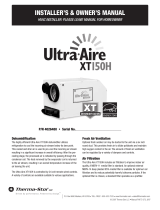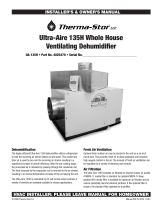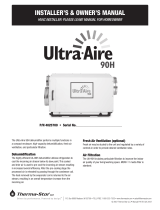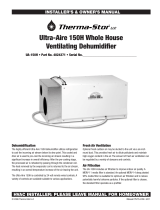Aprilaire 1820 Installation guide
- Category
- Dehumidifiers
- Type
- Installation guide

READ AND SAVE THESE INSTRUCTIONS
CAUTION
1. Read all instructions before beginning installation.
2. Improper installation may cause property damage or injury. Installation, service, and maintenance must be performed by a
qualified service technician.
3. Do not use in pool applications. Pool chemicals can damage the dehumidifier.
4. Do not use solvents or cleaners on or near the circuit board. Chemicals can damage circuit board components.
5. Wait 24 hours before running the unit if it was not shipped or stored in the upright position
WARNING
1. 120 Volts may cause serious injury from electric shock. Disconnect electrical power before starting installation or servicing.
Leave power disconnected until installation/service is completed.
2. Sharp edges may cause serious injury from cuts. Use care when cutting plenum openings and handling duct work.
3. Dropping may cause personal injury or equipment damage. Handle with care and follow installation instructions.
SAFETY INSTRUCTIONS
TABLE OF CONTENTS
Safety Instructions........................................1
Specifications............................................2
Set Up Dehumidifier for Installation ........................2
Packaging Content .......................................2
Duct Collars ............................................2
Location Considerations...................................3
Installation...............................................3
Leveling ...............................................3
Ductwork Installation.....................................3
Drain Tubing and Condensate Pump Installation ...............4
Model 76 – Crawl Space Control and Wiring ................5
Air Cycling...............................................5
System Set-Up, Check & Start-Up ..........................6
Remote Control – Crawl Space.............................6
Ventilation / Air Cycling...................................7
System Check...........................................7
Crawl Space Using the Dehumidifier Control..................8
Crawl Space Remote Control Using Model 76 .................8
Start-Up ...............................................8
Troubleshooting ..........................................9
Table 1 – Diagnostic Codes................................9
Table 2 – Troubleshooting Guide...........................10
Service Parts............................................11
Model 1820 Dehumidifier
Installation Instructions
1

CLIP OFF
PLASTIC
STRAP
REMOVE SHIPPING BRACKET
FIGURE 1 – Remove Shipping Bracket
90-2302
IMPORTANT: Cut the strap securing the compressor
shipping support bracket and remove the strap and shipping bracket.
See Figure 1.
SET UP DEHUMIDIFIER FOR INSTALLATION
SPECIFICATIONS
Model 1820
Weight
56 lbs.
Capacity: AHAM DH-1-2008 80°F, 60% RH Conditions 70 pints per day @ 200 CFM
Power: 115 VAC, Single Phase, 60Hz 5.8 Amps operating current
Dehumidifier Inlet Air Conditions
Dehumidification: 50°F – 104°F, 40°F dew point minimum
Ventilation: 40°F – 140°F, 0%RH – 99%RH (non-condensing)
Filter
MERV 8, washable
Airflow
200 CFM
1. Dehumidifier
2. Inlet/Outlet Collars
3. Literature
a. Installation Instructions
b. Owner’s Manual
4. Parts Bag
a. #10 x 1/2 Screws (9)
b. Threaded Barbed Fitting for Drain
Connections
c. Torx Bit
5. 10 foot, 3/4” Drain Tube
PACKAGING CONTENT
Use the screws in the parts bag to attach the duct
collars to the inlet and outlet of the dehumidifier.
See Figure 2.
OUTLET
DUCT
COLLAR
INLET
DUCT
COLLAR
FIGURE 2 – Install Duct Collars
90-2308
DUCT COLLARS
2

LOCATION CONSIDERATIONS
6"
13"
ELECTRICAL
SERVICE ACCESS
THIS SIDE
MINIMUM
CLEARANCE
FOR PROPER
AIR FLOW
8 FT. POWER CORD
FILTER
MINIMUM
CLEARANCE
FOR FILTER
TOP VIEW
FIGURE 3 – Filter Access Clearance
90-2304
• Allow sufficient clearance for filter removal and
to prevent airflow obstruction
• Electrical service access will require the removal
of the side panel shown. Allow sufficient space
for service on this side of the unit.
0.38" MIN
2.00" MAX
3/4" FNPT DRAIN
INSTALLATION
LEVELING
DUCTWORK INSTALLATION
The feet can be adjusted to level the unit, and
if required, to accommodate drain fittings and a
secondary condensate pan. Leveling is required
to ensure proper drainage from the dehumidifier.
See Figure 4.
Adding 5-10 feet of insulated ductwork to the inlet and outlet of the dehumidifier will ensure dehumidified air is circulated throughout the crawl
space and will reduce the noise level of the dehumidifier. Point the inlet and outlet ducts in opposite directions to minimize recirculation of
dehumidified air.
• Maximum recommended total duct length is 100 feet.
• To avoid pulling in dirt and other particles, do not lay intake duct on the floor of the crawl space.
NOTE: This dehumidifier is designed for crawl space and stand-alone applications only. Do not duct to HVAC system.
FIGURE 4 – Level the Unit
90-2305
3

INSTALLATION (CONTINUED)
DRAIN TUBING AND CONDENSATE PUMP
INSTALLATION
The drain outlet on the dehumidifier can be plumbed
directly to a condensate pump (see Figure 5) using
the provided 3/4” MNPT x 3/4” hose barb fitting
and 3/4” clear PVC tubing. Always maintain a
constant downward slope from the dehumidifier to
the condensate pump. NOTE: PTFE thread seal tape
is recommended for the threaded connection. Hand
tighten only. The 4856 condensate pump is capable
of lifting water up to 22 feet. The dehumidifier can
be elevated (while remaining level) to increase
downward slope for proper draining. Wire the float
switch terminals to the normally closed contacts on
the condensate pump (see Figure 6).
8" DIAMETER
INSULATED
FLEX DUCT
3/4" CLEAR PVC TUBING
(INCLUDED)
CONDENSATE PUMP
FLOAT SWITCH
WIRE
3/4" MNPT x 3/4"
BARB FITTING
(INCLUDED)
FIGURE 5 – Drain and Condensate Pump Installation
90-2306
FLOAT
Switch
DH DH
LOW VOLTAGE NORMALLY CLOSED
CONTACTS ON CONDENSATE PUMP
FIGURE 6 – Float Switch Wiring
90-1857
4

MODEL 76 – CRAWL SPACE CONTROL AND WIRING
NOTE: Use 18-22 AWG wire for control wiring.
Used as a crawl space control (or remote control),
the Model 76 is mounted in the living space while
the dehumidifier is located in the crawl space.
When the dehumidifier is powered, the display on
the dehumidifier control will show “REMOTE” to
indicate that a remote control is being used. The
RH shown on the Model 76 is the RH measured at
the dehumidifier.
NOTE: Air Cycling is not an option when using a
Model 76 as a remote control.
+ -ABODT
SensorRemote
Gh Rf Cf Gs YW
HVAC EQUIP.
DH
DH
R/+
C/-
B
A
MODEL 76 CONTROL
FIGURE 7 – Model 76 Crawl Space/Sealed Attic (Remote) Wiring
90-1860
AIR CYCLING
The dehumidifier has an optional ventilation feature that can be used to circulate air through the dehumidifier, to promote uniform humidity
levels throughout the space. When this feature is enabled, the dehumidifier fan can be set to run from 0 minutes (no air cycling) to 60 minutes
(continuous) per hour. See VENTILATION / AIR CYCLING in the SYSTEM SET-UP, CHECK & START-UP section on page 7.
NOTE: The on-board control must be used when Air Cycling.
5

SYSTEM SET-UP, CHECK & START-UP
If using a Model 76 Remote Control and/or the Air Cycling feature,
proceed to Step 1 below. If not using either feature, proceed to
SYSTEM CHECK on page 7.
1. Check all wiring.
2. Make sure the wire access cover has been snapped back onto the
on-board control.
3. Plug unit in and turn power switch to ON. The power switch is
located on the dehumidifier outlet next to the power cord.
4. The on-board control screen should display OFF.
90-1854
NOTE: If the display backlight is not on, the first button press (any
button) will only turn on the backlight. Press the button a second time
to achieve function.
5. Hold the MODE button on the on-board control for 3 seconds to
enter the Installer Set-up Menu.
6. Navigate through the following screens to set up the dehumidifier
for the installed application.
Use the UP or DOWN arrows to select items and use MODE to
switch to the next set-up option. To exit installer set-up, all options
must be scrolled through using the MODE button.
7. After the installer set up options have been completed, DONE will
blink for 3 seconds and the control will return to the OFF screen.
90-1854
90-1854
REMOTE CONTROL – CRAWL SPACE
90-1854
If not installing in a crawl space
with Model 76 remote control,
press MODE to go to VENT screen
selections
90-1854
If installing in a crawl space with
remote control, Enable and press
MODE. The installer set-up is
complete, proceed to SYSTEM
CHECK on page 7.
NOTE: Air Cycling is not an
option when Remote is enabled.
6

90-1854
Press and hold the ON/OFF button
and MODE buttons for 3 seconds.
The measured humidity, AIR
SAMPLING and TEST will show on
the display.
90-1854
After three (3) minutes the
dehumidifier compressor will
turn on and DEHUMIDIFYING will
replace AIR SAMPLING on the
control screen.
90-1854
90-1854
After one minute of compressor
operation, all outputs will turn off
and DONE will blink for 3 seconds
and then return to the OFF screen.
SYSTEM CHECK
SYSTEM SET-UP, CHECK & START-UP (CONTINUED)
VENTILATION / AIR CYCLING
90-1854
If not using the dehumidifier to
periodically cycle air in the crawl
space, press MODE to go to ZONE
screen selections.
90-1854
If using the dehumidifier for air
cycling, Enable and press MODE.
90-1854
Press MODE at the VENT TIMED
screen to go to ventilation time
selection screen.
90-1854
Press the UP or DOWN arrows
to adjust the ventilation time
per hour from 0 to 60 minutes.
After selecting time, press
MODE. Press MODE through the
ZONE, EXTERNAL, DEH w/AC,
and RH offset screens. DONE
will be displayed on the screen
and Installer Set-up is complete.
Proceed to SYSTEM CHECK. on
page 7.
7

SYSTEM SET-UP, CHECK & START-UP (CONTINUED)
Your dehumidifier is equipped with two features that protect against unwanted energy consumption. Defrost is a normal operating mode that
helps to prevent significant ice formation on the refrigeration system coil. The dehumidifier display will show “DEFROSTING” when operating
in this mode. This mode can occur when there is not enough air moving through the dehumidifier or if the temperature and/or humidity of
the incoming air is too low. The second protection feature is the E8 code. E8 on the dehumidifier display indicates that the air entering the
dehumidifier is below 50°F or above 104°F, or the dew point of the incoming air is below 40°F. There would be a significant reduction in
dehumidifier efficiency if the dehumidifier operated outside of these conditions. Low dew point conditions can be seen in some basements
or crawl spaces and usually occur in the Winter and Spring months. The dehumidifier continues to monitor the incoming air and when the
conditions are within the operating range, E8 will be removed from the display and dehumidification will begin as needed.
START-UP
CRAWL SPACE USING THE DEHUMIDIFIER CONTROL
CRAWL SPACE REMOTE CONTROL USING MODEL 76
1. Press the ON/OFF button to turn the dehumidifier control ON. The display will show the current setting, and the dehumidifier blower and HVAC
blower (if wired to the HVAC system) will turn on to start sampling the air.
The setting will be replaced by the measured humidity and “AIR SAMPLING” will show on the display.
2. Use the UP or DOWN button to adjust the humidity setting as desired. The recommended initial setting is 59%.
3. After three (3) minutes of sampling, the measured humidity will be compared to the setting:
a. If the humidity is above the setting, the dehumidifier compressor turns on and “AIR SAMPLING” will be replaced by “DEHUMIDIFYING”. The
compressor remains on until the measured humidity falls 3% RH below the setting.
b. If the measured humidity is below the setting, the blowers turn off and the display returns to showing the RH setting.
4. The dehumidifier will sample again every 60 minutes, or at any time if the humidity setting is lowered.
1. Press the ON/OFF button to turn the dehumidifier control ON. “REMOTE” will show on the display to indicate that a remote control is wired to
the dehumidifier.
2. At the Model 76, press the ON button; the Model 76 will display the RH measured at the dehumidifier, and the dehumidifier blower will turn
on to start sampling the air.
3. Use the UP or DOWN button on the Model 76 to adjust the dryness level as desired. The dryness levels are from 1 to 7, with 1 being least dry
and 7 being most dry; the recommended initial setting is 3.
4. After three (3) minutes of sampling, the measured humidity will be compared to the setting:
a. If the humidity is above the setting, the dehumidifier compressor turns on and “ON” flashes on the Model 76 display.
b. If the measured humidity is below the setting, the dehumidifier blower turns off.
5. The dehumidifier will sample again every 60 minutes, or at any time if the dryness level is increased.
8

Technical Support is available Monday through Friday, 7:00 a.m. to 5:00 p.m. CST, at (800) 334-6011. Use the guides on the following pages to
identify and correct system faults. Contact Technical Support before replacing the unit or any components and for additional troubleshooting.
DIAGNOSTIC CODES
When an error occurs, the Diagnostic Code along with SERVICE REQUIRED
will be displayed on the control screen.
90-1854
TABLE 1 – Diagnostic Codes
Diagnostic
Code Failure Mode Action Reset
E1 Internal Humidity or
Temperature Sensor
Open or Shorted
1. Check the connection between the sensor board and control board.
2. If connection okay, replace sensor board, Part No. 5460.
Cycle Power
E2 High Refrigeration
Pressure
1. Verify that the fan works and there is no blocked or restricted ductwork.
2. If the fault persists, call Technical Support.
Cycle Power
E3 Model 76
Remote Control
Communication Loss
1. Check connections between Model 76 and dehumidifier control board. Terminals should be fully
inserted and secured in the control board and Model 76 control terminals.
2. If connections are correct and secure, turn off the dehumidifier and remove the Model 76.
Use a short section of 4-wire cable to reconnect the Model 76 to the control board. Turn the
dehumidifier back on and increase the dryness level setting on the Model 76. If the dehumidifier
turns on, the problem is with the wiring between the dehumidifier and control.
3. If the dehumidifier does not turn on, call Technical Support.
Self-Correcting
E4 Insufficient Capacity 1. Check the frost sensor connection at the power board. Terminal should be fully seated on the
power board pins.
2. Remove the side access panel and verify that the sensor is secured to the suction line.
3. If the sensor is connected and secured to the refrigeration line proceed to the next step.
4. Reset the fault by cycling power to the dehumidifier.
5. Turn the humidity setting down (below room/home humidity level) to make a dehumidification call.
6. Allow the fan and compressor to run for approximately 10-15 minutes and then enter diagnostic
test mode by simultaneously pressing the UP ARROW and MODE buttons for 3 seconds. The
LCD will display the temperature measured by the internal sensor while also displaying AIR
SAMPLING and ON, the humidity measured by the internal sensor while also displaying %RH
and ON, and the frost sensor temperature while also displaying ON. Scroll through these values
and by using the UP/DOWN arrow buttons.
7. Record values and call Technical Support.
Cycle Power
E5 High Temperature
Thermistor Failure
1. Check the high temperature sensor connection at the power board. Terminal should be fully
seated on the power board pins.
2. Remove the side access panel and verify the sensor is not damaged and connected to the
refrigeration line coming from the compressor.
3. If the sensor is connected and secured to the refrigeration line, contact Technical Support.
Cycle Power
E6 Low Temperature
Thermistor Failure
1. Check the low temperature sensor connection at the power board.
2. Remove the side access panel and verify the sensor is not damaged and connected to the
suction line.
3. If the sensor is connected and secured to the refrigeration line, contact Technical Support.
Cycle Power
E7 Float Switch Open 1. Empty the condensate pan.
2. Check the float switch connection at the control board.
3. If not using a float switch, verify jumper is between float switch terminals on dehumidifier
control board.
4. If the problem persists, replace the float switch.
Self-Correcting
E8 Inlet Air Temperature
Out of Range
50°F – 104°F or dew
point below 40°F
1. Verify all ductwork is properly sealed.
2. If no signs of leak points, contact Technical Support.
Self-Correcting
TROUBLESHOOTING
9

TROUBLESHOOTING (CONTINUED)
TABLE 2 – Troubleshooting Guide
Symptom Possible Reason Troubleshooting Procedure
Dehumidifier does not
turn on/run.
No power to unit. • Check that the dehumidifier is plugged in.
• Check that the power switch is turned ON.
• Check that the control is turned ON.
• Check that the circuit breaker has not tripped.
Dehumidifier blower is
running but with little or
no airflow.
Pressure drop across
dehumidifier is higher
than 0.4”w.c.
• Check dehumidifier air filter and wash or replace.
• Check for blocked duct work and clear.
Dehumidifier blower is
running but compressor
is not.
Float switch open. • If float switch installed, check connections at control board and empty condensate pan.
• If no float switch installed check that the jumper is installed at the float switch terminals on the
control board.
Coil frosting. • Lack of or reduced airflow. Check dehumidifier air filter and wash or replace.
• Check for blocked duct work.
• Inlet air conditions below 60°F. Increase the humidity setting.
Inlet air temperature is
outside of the 50°F –
104°F range or the dew
point is below 40°F and
there is a demand for
dehumidification.
• Verify all ductwork is properly sealed.
Dehumidifier is not
draining properly.
Drain line blocked or unit
not level.
• Verify that the unit is level.
• Check the drain line blockages and for a continuous downward slope.
Dehumidifier is
producing hot air.
Normal function. • Air is reheated across the condenser coil, resulting in a temperature rise between inlet and outlet,
this is normal.
10

No. Part Description Part No.
1 Filter, 8” x 11.75” x 1” EZK 5695
2 Internal Control Board, Deh 5444
3 User Interface Assembly, Deh 5445
4 Wiring Access Door, AA Deh 5446
5 Door, Filter Access, AA Deh 5696
6 Outlet Duct Panel, Deh 5698
7 Inlet Duct Panel, AA Deh 5699
8 Fan with 6MFD Capacitor 5694
9 Wire Harness, Power, Deh 5454
10 Sensor, Low Temperature, Deh 5455
No. Part Description Part No.
11 Sensor, High Temperature, Deh 5456
12 Leveling Foot, Deh 5457
13 Capacitor, 45MFD, 370VAC 5458
14 Capacitor, 6MFD, 250VAC 5582
15 RH Sensor, Deh 5460
16 Drain Tube + Fitting 5665
17 Compressor Overload Switch 5697
Not Shown
Condensate Pump with Tubing 4856
SERVICE PARTS
1
4
3
15
7
17
6
12
16
9
13
14
2
11
10
8
5
90-2298
11

AprilairePartners.com
P.O. Box 1467
Madison, WI 53701-1467
800.334.6011 F: 608.257.4357
Printed in USA
©2017 Aprilaire – Division of Research Products Corporation
10012343 B2207621B 9.17
-
 1
1
-
 2
2
-
 3
3
-
 4
4
-
 5
5
-
 6
6
-
 7
7
-
 8
8
-
 9
9
-
 10
10
-
 11
11
-
 12
12
Aprilaire 1820 Installation guide
- Category
- Dehumidifiers
- Type
- Installation guide
Ask a question and I''ll find the answer in the document
Finding information in a document is now easier with AI
Related papers
-
Aprilaire 1852 Owner's manual
-
Aprilaire E100C Owner's manual
-
Aprilaire E100C User manual
-
Aprilaire E130C User manual
-
Aprilaire E080 Owner's manual
-
Aprilaire E0080, E100 Owner's manual
-
Aprilaire 1850F Owner's manual
-
Aprilaire 1870F Owner's manual
-
Aprilaire E0080, E100 Owner's manual
-
Aprilaire E080CS Owner's manual
Other documents
-
Carrier DEHXXCDA1080-AO4 Cent Whole House 4 Pack Dehumidifier Owner's manual
-
 Therma-Stor Products Group XT150H User manual
Therma-Stor Products Group XT150H User manual
-
 Therma-Stor Products Group UA-135H User manual
Therma-Stor Products Group UA-135H User manual
-
Lennox HCWHD3 Series Whole-Home Dehumidifiers Installation guide
-
 Therma-Stor Products Group 90H User manual
Therma-Stor Products Group 90H User manual
-
Eglo 5460 Datasheet
-
York Whole House Dehumidifiers User manual
-
 Therma-Stor Products Group UA-150H User manual
Therma-Stor Products Group UA-150H User manual
-
Williams DH90 Installation, Operation And Maintenance Instructions
-
Williams DH90 Installation, Operation And Maintenance Instructions















